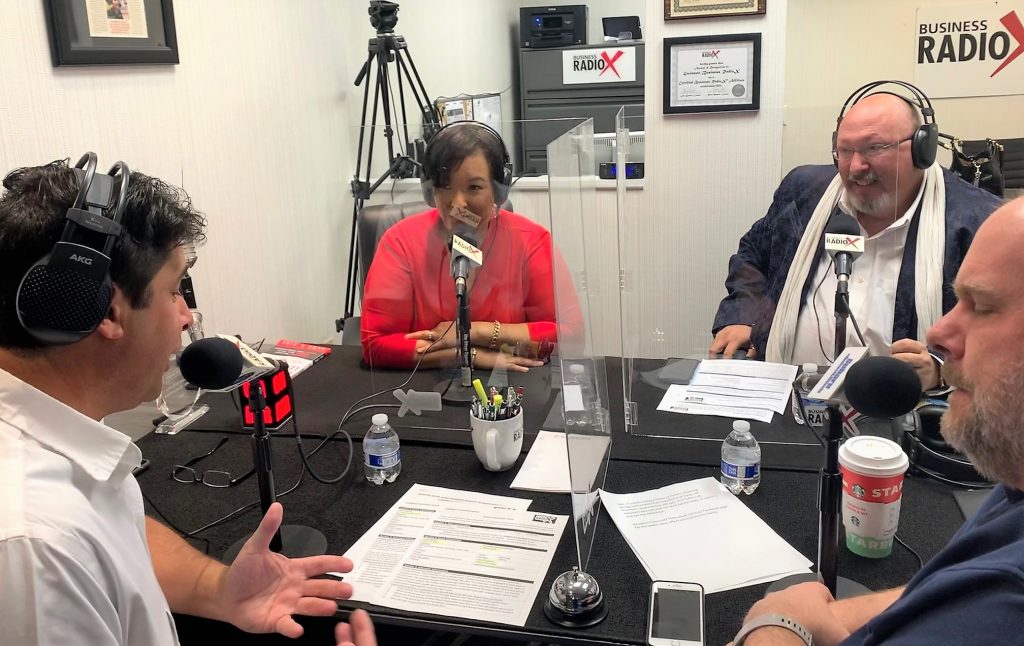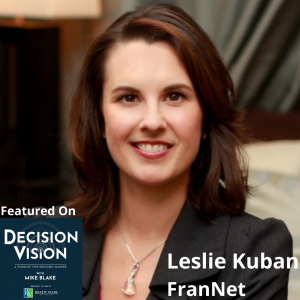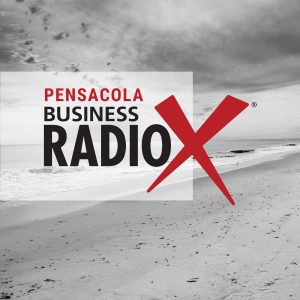Decision Vision Episode 99: Should I Hire a Consultant? – An Interview With Meredith Moore, Artisan Financial Strategies
Meredith Moore started hiring outside consultants very early to assist with her firm’s growth. She joins host Mike Blake to discuss why she has continued this practice, why she considers it so vital for her business, pitfalls you should avoid, and more. “Decision Vision” is presented by Brady Ware & Company.
Meredith Moore, Founder & CEO of Artisan Financial Strategies
Meredith Moore brings a passion for lifelong learning to her role as Founder and CEO of Artisan Financial Strategies. She is a class of 2017 leadership Atlanta graduate and has built a practice where clients and colleagues alike appreciate Meredith’s unflagging commitment to empowering others through knowledge, skills and insights that help them meet financial and personal goals through a comprehensive and bespoke process. In addition, she has mentored dozens of other financial advisors in the industry.
Her fresh approach and insightful observations combine with 21 years of professional experience to make Meredith a compelling and sought-after speaker. She has guest lectured at Georgia Tech’s Scheller College of Business, spoken at the Wall Street Journal’s Women in the Workplace and on the WSJ Secrets of Women of Wealth podcast. She is also a contributor to Medium and Thrive Global.
As someone who’s not only beaten cancer but kicked its ass, Meredith has a growth mindset and firmly believes that perseverance and a methodical approach allow individuals to achieve any goal.
You can connect with Meredith on LinkedIn.
Meredith Moore of Artisan Financial Strategies, LLC, is a financial adviser with Eagle Strategies LLC, a Registered Investment Adviser. Artisan Financial Strategies, LLC, is not owned or operated by Eagle Strategies LLC or its affiliates. Neither Artisan Financial Strategies, LLC, nor its advisors provide tax, legal, or accounting advice. This is for informational purposes only and should not be construed as investment advice.
Mike Blake, Brady Ware & Company

Michael Blake is the host of the “Decision Vision” podcast series and a Director of Brady Ware & Company. Mike specializes in the valuation of intellectual property-driven firms, such as software firms, aerospace firms, and professional services firms, most frequently in the capacity as a transaction advisor, helping clients obtain great outcomes from complex transaction opportunities. He is also a specialist in the appraisal of intellectual properties as stand-alone assets, such as software, trade secrets, and patents.
Mike has been a full-time business appraiser for 13 years with public accounting firms, boutique business appraisal firms, and an owner of his own firm. Prior to that, he spent 8 years in venture capital and investment banking, including transactions in the U.S., Israel, Russia, Ukraine, and Belarus.
Brady Ware & Company
Brady Ware & Company is a regional full-service accounting and advisory firm which helps businesses and entrepreneurs make visions a reality. Brady Ware services clients nationally from its offices in Alpharetta, GA; Columbus and Dayton, OH; and Richmond, IN. The firm is growth-minded, committed to the regions in which they operate, and most importantly, they make significant investments in their people and service offerings to meet the changing financial needs of those they are privileged to serve. The firm is dedicated to providing results that make a difference for its clients.
Decision Vision Podcast Series
“Decision Vision” is a podcast covering topics and issues facing small business owners and connecting them with solutions from leading experts. This series is presented by Brady Ware & Company. If you are a decision-maker for a small business, we’d love to hear from you. Contact us at decisionvision@bradyware.com and make sure to listen to every Thursday to the “Decision Vision” podcast.
Past episodes of “Decision Vision” can be found at decisionvisionpodcast.com. “Decision Vision” is produced and broadcast by the North Fulton studio of Business RadioX®.
Visit Brady Ware & Company on social media:
LinkedIn: https://www.linkedin.com/company/brady-ware/
Facebook: https://www.facebook.com/bradywareCPAs/
Twitter: https://twitter.com/BradyWare
Instagram: https://www.instagram.com/bradywarecompany/
SHOW TRANSCRIPT
Intro: [00:00:02] Welcome to Decision Vision, a podcast series focusing on critical business decisions. Brought to you by Brady Ware & Company. Brady Ware is a regional full service accounting and advisory firm that helps businesses and entrepreneurs make visions a reality.
Mike Blake: [00:00:22] Welcome to Decision Vision, a podcast giving you, the listener, clear vision to make great decisions. In each episode, we discuss the process of decision making on a different topic from the business owners’ or executives’ perspective. We aren’t necessarily telling you what to do, but we can put you in a position to make an informed decision on your own and understand when you might need help along the way.
Mike Blake: [00:00:41] My name is Mike Blake, and I’m your host for today’s program. I’m a director at Brady Ware & Company, a full service accounting firm based in Dayton, Ohio, with offices in Dayton; Columbus, Ohio; Richmond, Indiana; and Alpharetta, Georgia. Brady Ware is sponsoring this podcast, which is being recorded in Atlanta per social distancing protocols. If you like this podcast, please subscribe on your favorite podcast aggregator and please consider leaving a review of the podcast as well.
Mike Blake: [00:01:08] Today’s topic is, Should I hire a consultant? And, you know, I think this is one of the more challenging questions that many of us, as business decision makers, face. And whether it’s your first time hiring a consultant or whether it’s something that you do in the routine course of business, it is difficult. And as we’re going to talk about today, it’s even more difficult, maybe, or difficult in a different way at a minimum than hiring an employee, because the power dynamic is different, the communication dynamic is different, the degree to which you and the method by which you influence the outcome of that decision to retain a consultant is different.
Mike Blake: [00:02:02] And as most of us know, our economy is becoming increasingly consultantized. We’re being more confronted with this notion of a gig economy. Many of you listening to this may be consultants now or you had been employees earlier this year or even five years ago. And so, I think there’s a lot of use to this conversation because we can get into the mind of somebody who’s been on the hiring side of consultants, has not been afraid to use them and work with them, and understanding kind of the mind of somebody who’s had a successful – and maybe we’ll find out unsuccessful – experiences retaining consultants.
[00:02:49] And I hope that’s going to give you a framework for deciding whether or not that that’s something that you want to do or if you are doing it, if you want to continue to do it. Because, you know, one of the things we’re going to cover today is whether or not you’re using a consultant for the right job. It can sometimes, I think, be so alluring this notion that you use consultants and we’re told now you need to outsource everything because that’s how you scale. And, you know, on paper, that’s all well and good. But, you know, there’s a difference between paper and doing this in real life.
Mike Blake: [00:03:22] So, joining us today to help us kind of talk through this is a very good friend of mine, Meredith Moore, who is founder and CEO of Artisan Financial Strategies. Clients and colleagues alike appreciate Meredith’s unflagging commitment to empowering others through knowledge, skills, and insights that help them meet financial and personal goals. Her boundless drive and curiosity are always evident, whether she’s creating a comprehensive financial plan, working to understand and advance women’s issues, or serving as a mentor for other professionals. Meredith holds a Bachelor of Industrial and Systems Engineering from Georgia Tech – by the way, that’s a big deal. Those of you who don’t know, Georgia Tech has still has a major gender imbalance. So, not many women graduate from that program – where she has served on numerous boards.
Mike Blake: [00:04:12] And is a 2017 graduate of Leadership Atlanta, the second best class ever. And her numerous awards and community leadership activities, including – I’m not going to read the whole thing because otherwise we’re going to be here for too long. But I am going to highlight certain things that I think you, as a listener, need to know about her. And I don’t want to highlight as well. She was named the 2018 Goodyear North Fulton Chamber Business Woman of Excellence. She is, as I mentioned, a Leadership Atlanta Class of 2017. I was a member of the class of ’14. And she’s on the Leadership Atlanta Committee for the group’s first women’s forum and moderator of the panel discussion, Critical Issues Facing Women Breadwinners 2017 and 2018.
Mike Blake: [00:04:58] She and I were both on the Atlanta Business Chronicle Top 40 under 40, 2009. I’m not going out Meredith, but I can tell you, for me, I made that under the wire in terms of eligibility. She is on the board of directors – or was on the board of directors for Kate’s Club from 2012 to 2014. She’s a multiple year Atlanta five star wealth manager. She does a ton of mentoring and also has been guiding families and patients around the world that have been diagnosed with glioblastoma, which is based on her personal experience with the disease. And for those of you who aren’t familiar, that is the same form of cancer that took Senator Ted Kennedy of Massachusetts about a decade ago.
Mike Blake: [00:05:42] As someone who’s not only beaten cancer but kicked its ass, Meredith firmly believes that perseverance and a methodical approach allow individuals to achieve any goal. In addition to our client service and community leadership, Meredith is a widely respected writer who brings a unique perspective to every topic. Her fresh approach and insightful observations combined with 20 years of professional experience to make her a compelling and sought after speaker. And I can tell you she’s sought after because I sought after her and she’s here today. She’s a personal growth junkie, fitness enthusiast, and self-confessed foodie who enjoys finding unique restaurants around Atlanta. A lifelong resident of Georgia, she lives in Roswell with her family, who definitely appreciate Meredith’s energy and drive, but are less enamored with her practice of seizing the day by about 5:00 a.m. each morning. And I’m with your family, if I do that, I’m a disaster. Meredith, welcome to the program.
Meredith Moore: [00:06:33] Thanks, Mike. It’s good to be here. And, again, it’s like the band’s back together.
Mike Blake: [00:06:39] I’m so excited to have you on this program. It’s really too long. We’re coming up on two years of the program, incredibly, and I’ve been trying to find kind of just the right topic to bring you in on. I know people who do what you do really can’t come on the media to talk about investing because people from the SEC will just burst down your door and take your microphone away, so you can’t do that. But, you know, I think it’s worth saying for the listeners that Meredith has been an informal mentor of mine. I don’t think she realizes that she’s been a mentor of mine. Most people don’t.
Mike Blake: [00:07:20] But the way that you’ve grown the business and what I’ve gone on record many times saying, I think your business is one of the toughest out there. I think it is the toughest in finance for a lot of reasons. Not least of which because it requires such a breadth of skill set in order to do well. You cannot just be a great adviser. You have to be so many things to do well at it. And so, you offer sort of a smorgasbord of expertise. And one thing we were talking about not long ago was talking about hiring consultants. And that was sort of the light that went off my head, “Okay”. I know that we can have a really good conversation about this. So, can you think back to when was the first time that you hired a consultant?
Meredith Moore: [00:08:16] Yeah. Actually, I can. So, you know, let me start by saying that I am a firm believer in hiring the very best consultants that you can afford. Now, that is a subjective statement. So, in the spirit of a true Georgia Tech grad – and by the way, in terms of your earlier comments with sort of gender balance there, it’s gotten a little bit better. But we used to say in the 90s, like, the odds are good, but the goods are odd.
Meredith Moore: [00:08:50] But I will tell you, so my first consultant was a business coach, and I tried to systematically since then, literally, take bottom line and make sure that I am spending 10 to 15 percent of my bottom line every year on the very best consultants that those dollars can buy. Because I know I can get return on investment off human capital. And if I have an initiative that I’m working on, you do your due diligence, I know my budget, I researched everything about it, and then I know the best questions to ask. But my first consultant was a business coach that had worked in nothing but advisory. And looking back, he was not the right fit for me for a lot of reasons, and we can go there, too. But I’ll just start by saying it was a business coach.
Mike Blake: [00:09:54] So, this is going to be a record, we’re going to go off the script after question one.
Meredith Moore: [00:10:01] I told you, one question. Yeah.
Mike Blake: [00:10:03] Well, we had an inkling that might happen. But 15 percent, that’s a fascinating number. And so, as your company has grown, you’ve sustained that 15 percent.
Meredith Moore: [00:10:16] And every year I seek on where I need to spend it. By the way, I learned that from Darren Hardy. So, Darren Hardy, as you may remember, was the publisher of SUCCESS Magazine, and he’s one of my mentors. I’ve never met him. Like, one of my big goals, I have a revenue number I’m trying to hit. And it’s my reward to myself when I hit that number, I’m going to his high performance forum. So, I’m a complete fangirl. And I listen to his Darren Daily every morning as part of my morning success ritual. And he’s talked about that for years and I followed it. And my current business coach also follows that. And so, I’m very intentional about making sure – I call it my PD, my personal development budget, making sure that I spend that.
Mike Blake: [00:11:13] You know, it’s interesting you say that. I have a similar fanboy, really, fixation on Simon Sinek. And I’m hoping someday he’ll pick up this podcast and then pick up the phone and call me and want to come on. But maybe I should make that as my goal. I’m sure he does some sort of seminar or something that I can pay an ungodly amount of money and I can actually get in on that. That would be a good goal. And, you know, I don’t mind saying my obsession with him is bordering on the uncomfortable. So, I totally get it. But that virtual mentoring can be very helpful.
Mike Blake: [00:11:57] So, that first time you decided that you wanted to hire a business coach, what was the process that that led you to that?
Meredith Moore: [00:12:11] So, I was at what’s an an industry meeting from what they’re calling the Million Dollar Round Table. And there was a gentleman there, actually from Atlanta, which was rare because Million Dollar Round Table is held all over the country. He talked about coaching the issues and it wasn’t cheap. But one thing that I will say versus my peers, I’ve always understood the value in investing in my business and investing in myself. And I think a lot of people have a tougher time wrapping their head around that because they look at it as, “Hey, it’s another expense”. And not really looking on the other side of the balance sheet or the cash flow statement, as the case may be, in terms of what income is this realistically going to generate for me.
Mike Blake: [00:13:10] So, you just said something that I think is really smart, and I don’t think I would have thought of that in a million years, is, thinking about that balance sheet and the income statement. And I’m going to kind of repeat back to you what I think I heard and you tell me if I’m all wet, but the way you’re looking at that investment is that this is an expenditure. So, on your income statement, yeah, it shows this expenditure of – I’m just going to pick a number – $5,000 – it might have been more. It might have been less. It doesn’t matter. But then, as you do that, you now have an asset on your balance sheet of $5,000. That may wind up turning out more, right? And that then translates down into the equity part of the balance sheet. So, you really haven’t lost anything. What you have done is you’ve converted cash into something else. Unlike any asset, in theory, that, you know, other than cash, the assets should become worth more than whatever the value is on the balance sheet itself. Is that a fair way to put it?
Meredith Moore: [00:14:20] Yeah. That’s correct. Because I’m buying access to knowledge that I did not have. I’m buying access to best practices. I’m buying access to subject matter experts that are solely there without my own behavior biases in order to either improve myself or improve an aspect of our business that we would not have thought of.
Mike Blake: [00:14:47] So, at the outset, you talked about the first consultant that you hired, it didn’t work out. Everybody loves a good war story. So, would you be willing to share with us? We don’t need names, of course. But how did it not work out, first of all?
Meredith Moore: [00:15:06] Well, first of all, I will say, admittedly, this wasn’t my first marriage. So, the large ticket item at that point in my career, he had a harder time wrapping his head around that for the revenue that I was bringing in. So, a lot of the philosophies that we just discussed, he didn’t necessarily subscribe to them. And he, perhaps, didn’t believe in – I don’t know – my capabilities, maybe, as much as I did. And that snow knocked him. It was a fair assessment at that point in my career. And so, we had some sort of internal strife, if you will, around that.
Meredith Moore: [00:15:56] But in terms of the coach himself, I got some things out of it. I think stylistically, he didn’t really fit. And, again, this is not to knock him professionally, and this would have worked for some people. He was a deeply spiritual person. And after every session, wanted to perk up. And nothing wrong with that, but my thoughts were, this is a professional relationship, I’m really uncomfortable with that. And I just didn’t think that it was the time or place to do it. And I think that impacted sort of my own biases around that relationship.
Mike Blake: [00:16:46] You know, that’s really interesting. That’s really interesting. It actually goes back to a two part podcast we did a couple of months ago on, Should I mix my faith with my business? And that’s a case where, at least in your case, that may have added or detracted, I guess, from the the client/provider relationship. But it sounds like that actually surprised you that they weren’t necessarily that open about it. They sort of sprung it on you after you initiated the formal relationship.
Meredith Moore: [00:17:25] Yeah. And, again, he didn’t do it, certainly, out of malice or anything like that. It’s a part of who he was and who he is. But that’s not who I am. And I felt really uncomfortable with that. And it’s been so long, so I don’t know how I brought that up. The other thing is, he kept wanting me to do personal introductions, not to potentially other clients, but to women for him to meet somebody.
Mike Blake: [00:18:05] Really?
Meredith Moore: [00:18:08] Yeah. Yeah.
Mike Blake: [00:18:09] Man, that’s weird.
Meredith Moore: [00:18:11] Well, you know, I guess that’s one way of prospecting. So, it felt really inappropriate then. And looking back, of course, it was inappropriate.
Mike Blake: [00:18:29] So, let me ask you this, you, yourself, operate in a consultative capacity. I don’t know if you would characterize yourself as a consultant per se, but certainly you’re an adviser, which at least is related to consulting. Has being an adviser and growing yourself as a more effective adviser informed how you retain and work with consultants along the way?
Meredith Moore: [00:18:59] Yeah. It has a little bit. And to your point, so I am planning first. So, I would, first and foremost, identify as a consultant unilaterally. And this is where my practice is so different than many of my peers. And I can say that because I’m in multiple masterminds with dozens of other advisors. Almost every one of our clients pay us a consulting fee first, because I believe that fundamentally everything starts with a plan. And any implementation, regardless of product or whatever, is simply a byproduct of that. So, that’s a differentiator. But it also has to do with my identity as a consultant. And that certainly has informed me, because I think that methodology being sort of not usual in my space has allowed me to ask, perhaps, better questions to other consultants as we’ve gone on searches for very specific subject matter experts.
Mike Blake: [00:20:15] I would imagine, too, you know, to some extent it ought to be some kind of a virtuous cycle because with all these mastermind groups, because of your embracing engaging with consultants as part of your business and your development model, that it must also then give you more access to a wider range – or wider array, if you will, of consultants. It gives you a better chance to find exactly the right fit.2
Meredith Moore: [00:20:49] Exactly. And when you’re part of mastermind groups, especially people in your own space, you create scale because other people are using similar vendors. And my mastermind group, we’re across the country. And one of the mastermind groups I’m in, it’s my business coach. And then, he has hand selected top advisors all over the country. And because of his expertise was coaching some of the country’s top advisors. He’s created relationships with these vendors that in turn give us discounts. And then, he’s able to tell, with all the clients and those of us in the mastermind groups, like experiences. So, you can’t be a part of that network if you’ve performed poorly for an adviser. I mean, word is going to get out. And, again, you know, seeing what other people have experienced and knowing their professional and personal world, it’s enabled me to be able to ask better questions.
Mike Blake: [00:22:02] So, let’s maybe put ourselves back in your seat back when you hired that first consultant. Assume that a listener out there has never hired a consultant before. I’m sure there’s at least one. And they’re now listening intently saying, “Okay. Well, maybe mthis is something I want to do.” What is your process now for identifying and retaining a great consultant?
Meredith Moore: [00:22:33] So, I think, first, it’s very similar, as you mentioned earlier, to hiring an employee. I think, first, you have to define a very specific job description. You know, what is scope, what is functionality, and it starts there. Next, I think, you need to come up with a strong meeting rhythm or meeting cadence in which you do check ins or in which you need certain deliverables. And the more that you can sort of formulaically to develop that prior to going on your search, I think that helps manage expectations.
Meredith Moore: [00:23:15] I’m a massive believer in planning not just with what I do professionally, but as a business. In fact, next week my whole team, we’re going up to Blue Ridge, Georgia, to do 2021 business planning for the entire week. But it’s the same thing when you hire a consultant, you know, figure out a job description, very clear scope, very clear meeting cadence. And then, once you have that, now, I think you start talking to people that you know and trust that have similar situations to you in terms of who they may have hired and why they hired them. And maybe ask more questions again around, you know, how their engagement around back to scope, and how often they met, and what worked and what didn’t. That’s what I think is kind of the next step there.
Meredith Moore: [00:24:16] And only then do you have the conversation with the candidates. And I wouldn’t have the conversations with the candidates based on price yet. I’d only have it based upon their experience and sort of best in class. And then, you can figure out price points. And by figuring out the price points now and talking with these consultants, then I feel like you’re in a better place in the spirit of this podcast to make a better decision.
Mike Blake: [00:24:53] So, I want to talk about pricing, because I think, again, that’s another great point because there are a lot of layers to this. So, you know, you said at the outset of our conversation that your goal is to hire the very best consultants and, maybe, more broadly talent that you can possibly afford. And affordability means different things to different people and also at different times. And so, as you talk about pricing – it’s a long preamble to the question being this, which is – are there times where maybe what you’ll do because you are so committed to having the best and the brightest that you can afford, maybe you narrowed down their scope to get to affordability rather than compromise on talent to get all the scope that you want. Does that make any sense to you? And if so, how do you react to that?
Meredith Moore: [00:25:52] Right. No, you’re absolutely right. So, instead of Band-Aid, lesser talent, I would rather reduce scope and in-house take on the additional scope to make up the difference. Because I come back to human capital, it’s one of the best assets that you can have as part of your business. And a lot of people, I think, try to hinge on that. I know I certainly did for years in my practice and I paid dearly for it, but in other ways. So, in answer to your question, yes, I would reduce scope and over index on the person side of it. Because I’d rather start somewhere with them where they can understand my business. And as the revenues scaled up, we could scale up the scope over time to go with that.
Mike Blake: [00:26:55] Now, have you ever worked with a consultant where there was a pay per performance kind of regime so that you could connect the economics with the pricing? Have you ever done anything like that?
Meredith Moore: [00:27:08] I sure have. In fact, with my current business coach, I was on a performance model with him. And he had run that model before with advisers, had discontinued it, and then had reinstated it with, like, three or four clients, and I was one of them. And it was solely, we came up with like a benchmark which were based on sort of baseline revenues prior. And then, he got paid a percentage of growth over that. And it worked. Go ahead, I’m sorry.
Mike Blake: [00:27:49] No, please. I mean, I want to hear from you, not me.
Meredith Moore: [00:27:52] Yeah. So, in the beginning, you know, as you can imagine, it’s a win for me because I’m not having to pay him anything until I grew. And then, when you grow, that fee, it’s exponential and it can get out of control very quickly. I have a great relationship with him. And, obviously, I’m still part of his mastermind group. We still do coaching together. But at some point, he said, “Look. This is going to hurt your business.” Where, like the fee was getting to be high, high ten figures – not ten. You know, I wish it was ten figures. I’m sorry – high five figures. And he’s like, “This is going to kill your business, so we’re going to pause this and revert back to a flat fee. And then, you can pay this to me over time.” And so, I think in theory it works. And I don’t want to speak for him or anybody else working on performance like that. I think it works briefly until it doesn’t. And it can have a very negative impact had he wanted to fully honor that. But, you know, I’m just not sure that would work. But that’s the only time that I’ve done a performance driven relationship at any point with a consultant.
Mike Blake: [00:29:25] You know, what strikes me about that model is the amount of trust that’s required between consultant and client, because the consultant has to trust that you are going to basically do what they say. If you’re completely on contingency – if I’m completely on a contingency as a consultant, but you, as a client, don’t take the advice or you execute it badly, it fails to generate results but really not through my fault as the adviser. That’s a tremendous risk that I’m taking and one that I really can’t manage beyond simply selecting the right person with whom to partner.
Mike Blake: [00:30:07] And then, on your side, on the client side, there’s a lot of trust that has to be placed that, in fact, if you wind up becoming successful, you generate that financial success that you actually can, in fact, directly attribute it to the advice and support that consultant was providing, as opposed to, frankly, just dumb luck. And so, it requires an immense amount of trust, I suspect. In fact, I more than suspect. It showed itself through how that fee issue resolved, because that consultant realized that they were going to get rich and make you poor and they chose to not allow that to happen, which, obviously, speaks well of the integrity of that consultant.
Meredith Moore: [00:30:57] Yeah. And that’s absolutely right. And I think going in, like, I had to understand – look, I’m in the business of understanding people at a very deep level. And for me to do business with somebody, consultants included, especially with that when they’re going to get to know me at a deep level, I have to be able to trust them. And trust does not come easily for me. But once I do, I’m all in.
Meredith Moore: [00:31:33] But the coach ability piece, you’re right, is absolutely critical. And if we’re drawing parallels not just to consultants that I’ve hired, but people that hire me, that’s one of the things I talk about quite a bit, Mike. They pay me a flat fee and I’m like, “Look, we can do this.” But in some ways, very deliberately and from a psychology standpoint, I’m like, “You have to be coachable. If you’re not coachable, you know, please do not waste your money.” And I make this clear that this is a dictatorial relationship. I want you to be able to push back and feel comfortable pushing back. But if you’re not coachable and you have bright shiny object syndrome, which a lot of entrepreneurs do, I’m not going to be a fit for you. But if I can manage the expectation of the relationship with the frontend with that, I’ve, essentially, created an interesting power dynamic to where there’s clarity around who’s driving the bus, but the other person still has a big say in which way we turn.
Mike Blake: [00:32:55] So, I want to move on from selecting the consultant to the actual process of working with one. I’d like to get your perspective because I think you have a lot to say on this, what does it take to get started with a consultant? Or in other words, you know, when you sign the engagement and you get started, what kind of ramp up time or lead time is there for you to actually start extracting value versus you having to provide sort of the raw materials, if you will, that is needed for the consultant to build something that is useful to you?
Meredith Moore: [00:33:39] And, again, I always think of that, too, in terms of my professional process. I always think of it as the intake. We give significant homework for somebody to get for us. But I guess because that’s my world that I view it similarly. So, I think it takes time to get all the necessary items that they need. But sometimes I think it’s important to give stuff a good runway in terms of that person getting to know your business. And that runway can differ depending on back to what their scope is.
Meredith Moore: [00:34:22] So, I have two virtual assistants. One is in Brooklyn and one is here in Georgia up in Gainesville. And they do two completely different things. You know, with both of them, it took several months, but everything is dynamic with what I’m assigning to them. So, what’s been really critical, it’s no different than running teams, especially now virtual teams is what your meeting cadence. Like, how is stuff constantly changing? And that meeting cadence is critical in any relationship, and in whatever your internal team is, and what it is with a consultant. But what are the check ins need to be? And then, based upon that, you know, my hope is, especially in the beginning, they’re tighter together so that they can get to know your business more quickly. And then, as they start to really understand things, maybe you can space them out a little bit more.
Mike Blake: [00:35:34] Now, so moving beyond that then, there’s also just the ongoing relationship. And the next question brings to mind advice I got with my second full time job out of school, which was, never let a consultant wish your problems away. And what he meant by that was, talking about the time and effort that you need to manage a consultant. In other words, I think where I’ve seen most consulting relationships go awry is somebody thinks when they’ve hired a consultant, therefore, the problem has been solved. And it doesn’t quite work that way, is it? I mean, you do have to pay attention and actively be engaged in managing that relationship, don’t you?
Meredith Moore: [00:36:24] Yeah. In fact, I’m laughing because one of the things my coach said to me about two years ago, he said, “You can’t consult your way out of this problem.”
Mike Blake: [00:36:34] Okay. I like that.
Meredith Moore: [00:36:37] So, what he was trying to say was that, a lot of it was a mindset issue on my part. And just because I have the best subject matter expert on something, you know, sometimes we don’t like to think too woo woo on stuff. But, you know, if I couldn’t envision that certain kinds of clients would do business with me, it doesn’t matter how much great advice I got. And, again, because I do hire a lot of consultants and a lot of people know that in my space, but I had to do the work from a vision in a confidence standpoint to be able to think things were possible. And I’m the kind of person, I guess, being a true Georgia Tech grad, if I can’t see something, like, I have a hard time committing to it. It’s hard for me to say, “Well, I’m going to do 10x my revenue in three years.” “Okay. Well, that’s great. But how?” And that’s what he was talking about, was, I needed to see myself doing this specific goal, but I couldn’t get there until I could figure out the how.
Mike Blake: [00:38:03] You know, that reminds me, there’s a South Park episode – I haven’t watched the show in ages, but the South Park episode called the Underpants Gnomes. Somebody asked the gnomes, like, “Why are you doing this?” “Profit.” “Well, how?” And they put up this little easel that said, “Step one: Collect underpants. Step three: Profit.” I said, “Well, what’s step two?” And it just went into this feedback loop. And you’re right, you know, the how is so important. It’s amazing how often the how gets overlooked, isn’t it?
Meredith Moore: [00:38:46] It is. I’m laughing because having a high school sophomore, I’ve seen that episode multiple times. So, I share your humor on that. We’ve gotten a good laugh in this house on that episode.
Mike Blake: [00:39:01] Yeah. My wife and I, who has her own business in her own right, we talk about that episode a lot because it does sort of make you think about these things. So, you’re probably aware there are IRS rules that ensure that a consultant is actually a consultant and not a backdoor employee. Has that ever come up? Is that ever something that’s had to be on your radar screen? Or have you managed to stay very clear of that?
Meredith Moore: [00:39:29] It’s on my radar screen. And, again, you know, doing quite a bit of a big part of our practice, but we don’t do tax returns or give “obligatory” sort of statement as tax advice, accounting is a big ones in which we make recommendations. And so, I’m very familiar with having the specific definitions around what is a contractor and what is an employee. But for the most part, the role that consultants have played in my business really has been exactly that. And while they might still be around, they don’t have anything to do with the advisory side. And I’ve kept it really clean in that everybody in-house does nothing but financial advisory.
Meredith Moore: [00:40:25] But having a lot of these other sort of consultants out there, you know, fractional CFOs, marketing stuff, on and on, and on and on, coaches, it’s pretty cleanly – you know, they wouldn’t understand a 12b-1 fee if it hit him upside the head. So, that’s how I’ve been able to sort of bifurcate these other tranches of folks that are involved in the business, but more peripherally as a consultant.
Mike Blake: [00:40:59] So, you said something a minute ago that I didn’t think quickly enough, but I do want to come back to it because I think it’s a really important quote or important idea. There’s some problems you cannot consult your way out of. What’s an example of that? Where have you found that there’s had to be a line where you can’t consult your way out of that problem? There’s this work that you have to do on your own or you may have to hire somebody whose full time job is going to be to solve that problem.
Meredith Moore: [00:41:36] So, let’s give the context in which it was said. So, again, really to some degree, I’m at capacity right now. And in terms of growing, I couldn’t figure out how to do it. And that was Coach Joe’s comment to me at the mastermind group in front of my peers, and he said that lovingly. And everybody else in my group, we all care about each other. For me, the way I needed to do it was to figure out the how. So, how do I do this? And because, again, I couldn’t see how to get to that next revenue layer of growth. And so, actually, it’s like being stuck in the woods. Like, you’re stuck out there by yourself and you’ve got to just test and try different things.
Meredith Moore: [00:42:39] Ironically, ultimately, I did hire another consultant. I worked closely with Dorie Clark up in New York. She’s written some of the biggest business books that are out there now. And I spend $6,000 to 7,000 every year to spend, like, three hours with her. And she had given me some ideas. Now, I had to go execute and figure out how to get it done. But one of the best ideas that I got in my career was from her. And she knows nothing about advisory.
Meredith Moore: [00:43:15] And because of her, actually, is why I host a luncheon series, Mike, that you may be familiar with, called Interesting Women Leaders in the ATL. And that did not come from an advisory coach. That came from Dorie Clark up in New York, who’s written a number of bestsellers and knowing what I was was trying to do. But it wasn’t until that idea and when I started executing could I finally see the how. And how that component with what it was doing with my network could be the thing that could allow me growth.
Meredith Moore: [00:43:58] So, I know for me, it comes back to what we keep talking about, it’s the how. I can have the mindset. I can read my quarterly game plan every morning, which is what I do, by the way, at 5:00 a.m. I know who I am, where I’m trying to go, but it’s figuring out those things. And so, I bounced around in the woods, eventually hired Dorie, went to a few of her mastermind’s. And then, ultimately, started spending half days, got the ideas when I started implementing. Now I’m like, “I can see it. This can actually work. I can actually elevate. I can actually figure out now how to scale.” So, for me, I needed to bounce around for a while.
Mike Blake: [00:44:41] There’s a really interesting concept there that I want to kind of stay there a bit with. And that is, that, in effect, you ran into a limitation with one consultant. Clearly you thought the message or the advice you were being given was good. But there was a limitation in terms of their ability to support you with the how. Now, I think a lot of people, when they run into that, I think, they become frustrated. And they are tempted to think that the consulting model itself then is fundamentally broken and consultants are just shysters and you sort of spiral. And I’m sure you know where that internal monologue is going.
Mike Blake: [00:45:22] But what you did was a very high class decision. You said, “Okay. So, this individual got me to this point. Now, there’s this new point that I’ve got to get to. That person can’t get me there. But that doesn’t mean there’s not somebody else that can’t sort of pick up the baton and help me finish the race.”
Meredith Moore: [00:45:44] Right. And, actually, Coach Joe, he still coaches me, and he’s the one who made that comment. He had suggestions on the how but none of them really worked. But he still provides massive value in my business. But I needed to very quickly, like you said, understand that limitation. And, again, nobody in my mastermind had ever come up with this. But, I think, it’s just staying attuned, like you were saying in the beginning, there are so many hats that I wear. But by staying attuned in the personal development space, trying to read a lot, and things like that, it afforded me that mindset to go seek out somebody else around this part. And, actually, it was Dorie Clark’s book called Stand Out that brought me to her and to begin to work with her.
Mike Blake: [00:46:46] We’re talking with Meredith Moore of Artisan Financial Strategies and we’re talking about, Should I hire a consultant? Meredith, we don’t have a ton more time. And as I would have predicted, we’ve gotten through a fraction of the questions I had prepared, but that’s the way it goes. But one question I do want to put in front of you is, can you become addicted to a consultant or can you become addicted to consultants? Can you become sort of over-reliant upon them? And I mean, does that concept make any sense to you?
Meredith Moore: [00:47:24] I guess. I think you have to come up with, like, what’s their function and at what point – like, how do you judge – I think you used the term where they’ve outlived their usefulness – that sounds awful. But I think it’s figuring out when has the sort of clock run out with what they can bring to you. Because that’s going to happen too. I mean, think of all the best athletes. Ultimately, they don’t keep the same coach for their entire careers many times. And it’s understanding where that limit is.
Meredith Moore: [00:48:09] I don’t know that you can get addicted. My philosophy has been to create a very strong talent internal to the business. And then, essentially, where we have blind spots and what we can’t staff to, hire the best consultants to those areas.
Mike Blake: [00:48:31] Okay. So, I think another question that a lot of listeners are thinking about is, you know, consultants sometimes, I think, get a bad rep. Like, almost everything in the world sometimes deservedly, sometimes not. But the bad rep is, you know, consultants aren’t truly accountable. They’re hired guns. You can’t fire them the same way that you would an employee. You don’t “own” them or their time. How do you keep your consultants and your advisers accountable for the value that they’re supposed to provide you?
Meredith Moore: [00:49:16] I think they’re very clear metrics. Like in our team, we run a scorecard every week and we have to report within the team, like, where we are with our numbers. I’m accountable to all of my team even though I’m the main rainmaker and I’m the visionary, where my COO is the implementer. But I’m very clear with the scorecard on all of us. We all have specific things we have to do. And, really, consultants, it should be no different. If you don’t define what the expectation is and figure out how to very clearly understand performance and results, I mean, it should be pretty clear, like, somebody is either performing or they’re not. And if they’re not, why are they not? And then, over time, you can make a judgment if this is something that that’s a person issue, an individual issue, or is this a systemic issue if you don’t have the right kind of consultant? But I’m not one to give up, if you will, if the due diligence has been done properly and if the systems are in place to measure.
Mike Blake: [00:50:33] Okay. So, Meredith, we’re running out of time and I’ve got to let you get back to helping your own clients to do what they need to do. I’m sure that our listeners may have questions about working with consultants and, clearly, you have a lot to say on the subject that’s helpful. Can people reach out to you to learn more? And if so, what’s the best way to do that?
Meredith Moore: [00:51:00] Sure. Absolutely. So, my email is mmoore, M-O-O-R-E, @artisan, A-R-T-I-S-A-N, fs, like Financial Strategies, online.com. And our website is very similar, www.artisanfsoline.com. So, those are going to be the best places to reach out.
Mike Blake: [00:51:25] Well, great. That’s going to wrap it up for today’s program. I’d like to thank Meredith Moore so much for joining us and sharing her expertise with us.
Mike Blake: [00:51:34] We’ll be exploring a new topic each week, so please tune in so that when you’re faced with your next executive decision, you have clear vision when making it. If you enjoy these podcasts, please consider leaving a review with your favorite podcast aggregator. It helps people find us that we can help them. Once again, this is Mike Blake. Our sponsor is Brady Ware & Company. And this has been the Decision Vision podcast.
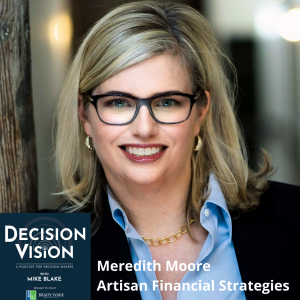
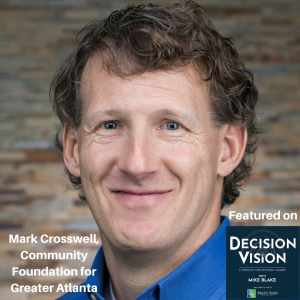

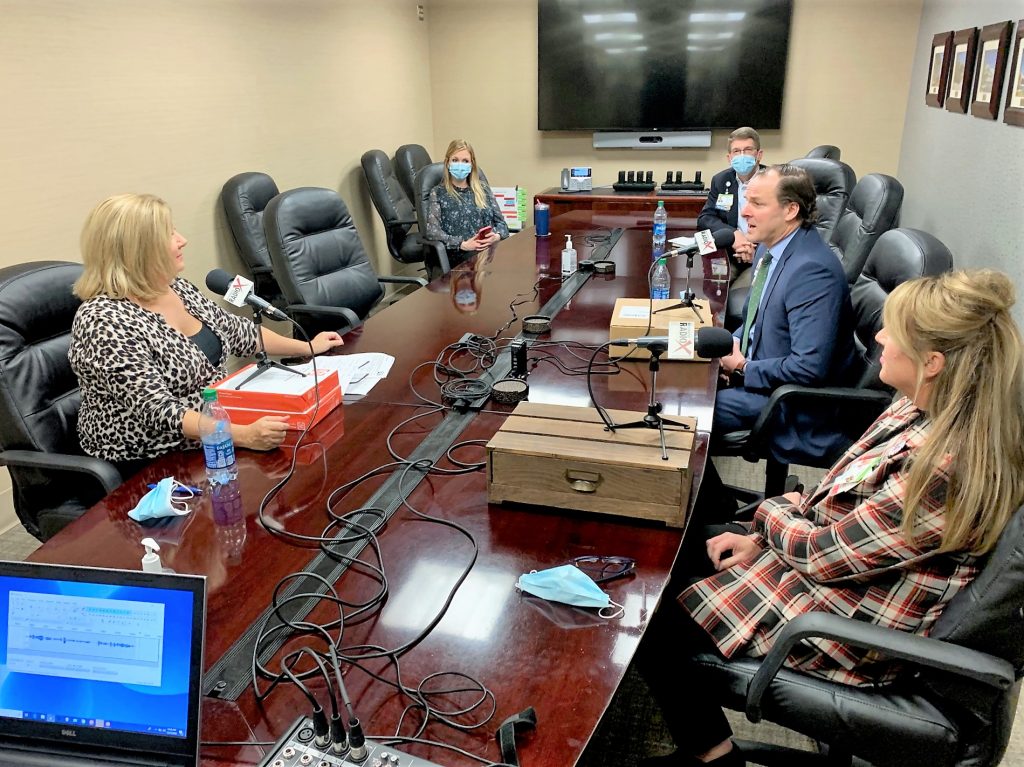




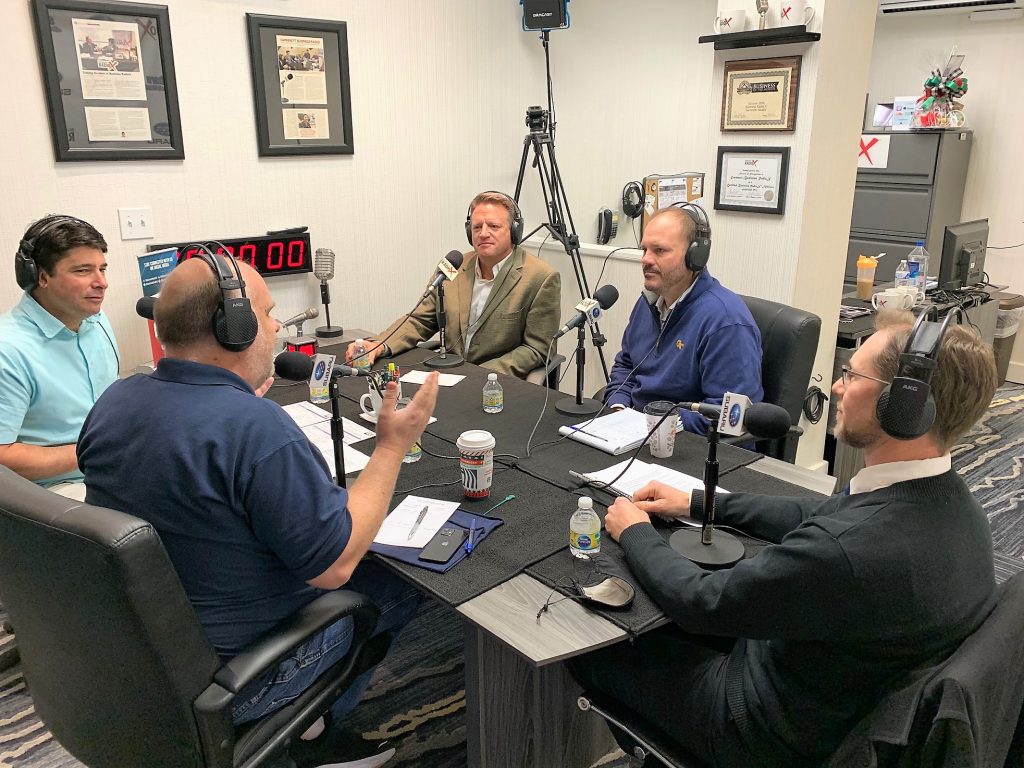

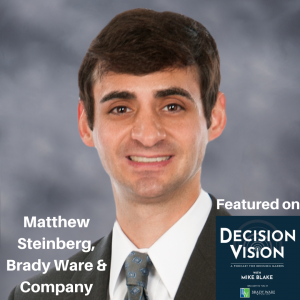

 Southern-born, Jennifer Hill Booker traveled to Paris to study French cooking at Le Cordon Bleu College of Culinary Arts only to discover that rustic French and Southern dishes use many of the same ingredients. Jennifer used this as the basis for culinary exploration in her second cookbook, Dinner Déjà Vu: Southern Tonight, French Tomorrow.
Southern-born, Jennifer Hill Booker traveled to Paris to study French cooking at Le Cordon Bleu College of Culinary Arts only to discover that rustic French and Southern dishes use many of the same ingredients. Jennifer used this as the basis for culinary exploration in her second cookbook, Dinner Déjà Vu: Southern Tonight, French Tomorrow.

 Tangela Davis is the COO and Co-Founder of
Tangela Davis is the COO and Co-Founder of 

 Thump-thump. How healthy is your leadership? Thump-thump. How engaged is your team? Thump-thump. Is your organization thriving? Not sure? It’s time for a heart check-up. Dawn S. Kirk, owner and founder of
Thump-thump. How healthy is your leadership? Thump-thump. How engaged is your team? Thump-thump. Is your organization thriving? Not sure? It’s time for a heart check-up. Dawn S. Kirk, owner and founder of 
